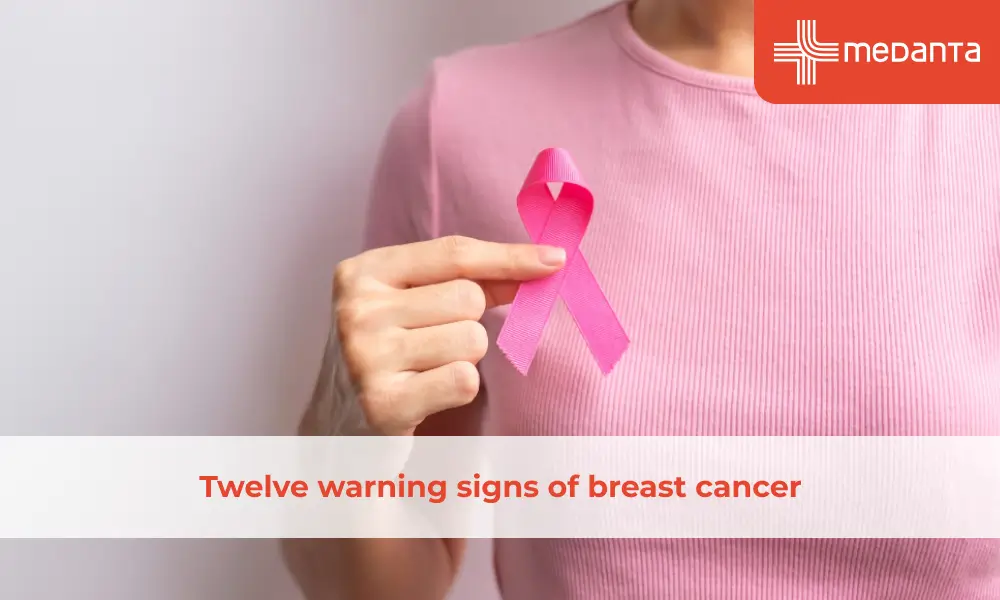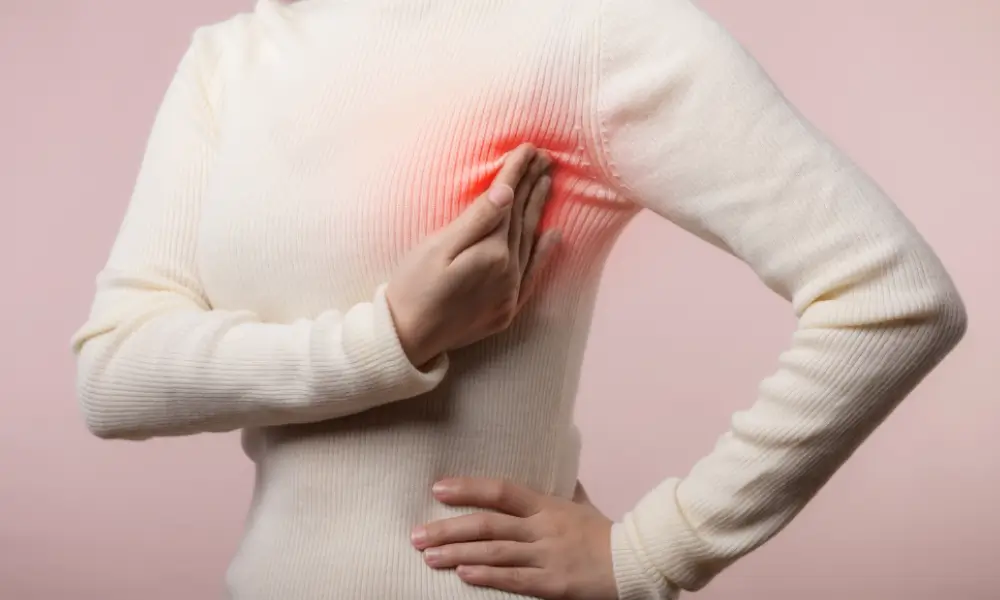Twelve warning signs of breast cancer

TABLE OF CONTENTS
Twelve warning signs of breast cancer
Breast cancer is the predominant cancer in Indian women, accounting for 14% of female cancer. In recent years, there is increase in prevalence in breast cancer cases in both rural and urban India. The risk of developing breast cancer increases as women age from their thirties to fifties, and the incidence rate peaks when they are between 50-64 years of age.
The chances of breast cancer survival become more difficult in higher stages of its growth, especially stage 3 and 4. According to various reports, the post cancer survival rate for Indian women with breast cancer is 60%, as opposed to 80% in the U.S. women.
Due to inadequate awareness about early detection and diagnosis, women in India have such a low breast cancer survival rate. But with proper guidance, women can self-diagnose the presence of any mass or lump in their breast. The fact is that, breast cancer is a treatable condition and survival rate becomes higher if we detect it earlier. The only way to decrease the numbers of death associated with breast cancer is being aware of its symptoms and take appropriate measures on time.
What is breast cancer?
As the name cancer involving breast cells is breast cancer. When the some breast cells divide more rapidly and abnormally than the rest healthy cells, can cause development of breast mass, which can be benign (non-cancerous) or malignant (cancerous). It can start in one or both breasts and can involve glandular tissues, milk ducts, areola, nipple, and skin area. Genetics, lifestyle, hormonal, and environmental factors play a crucial role in breast cancer development. Although the prevalence rate is lower but breast cancer can also occur in men.

What are the warning signs and symptoms of breast cancer?
Like other cancers, breast cancer can penetrate into surrounding tissues and can also metastasize to other parts of the body and form new tumor there. The breast cancer symptoms can differ from person to person. Regular self-inspection with their fingers, a woman can notice any abnormality in their breast and take appropriate measures. The following are some of the possible signs and symptoms of breast cancer:
Lump in breast:
Breast lump is the most common symptoms of breast cancer. One may notice an irregular, solid, and painless mass in breast area, which is different from the surrounding tissues. This lump or mass may not be always cancerous; it can be simple glandular cyst. In cancerous lump, the overlying skin may be redder and tender than rest skin.
Still, if you notice any new lump or mass in your breast area, it’s crucial to connect with your healthcare provider for proper assessment and treatment regimen.
Lump in the armpit or collarbone:
Swelling in armpit or collarbone can occur due to many reasons, and breast cancer is one of them. Lump in this area occurs when breast cancer cells spread to lymph nodes in armpits or collarbone. The cancerous lymph nodes appear hard and immovable, and sometimes become tender on palpitation. Sometimes, the lump or swelling in lymph nodes can occur before you can notice a lump in your breast.
Swelling in whole breast:
Swelling in and around the breast can be due to inflammatory breast cancer (IBC). It may not appear on diagnostic mammogram. The person may experience red, itchy, warmer, and tender breast.
Sudden variation in breast size and shape:
Sometimes, a woman may notice heaviness, burning, swollen, and redder breast. In breast cancer, one breast may visibly appear larger than the other. When you notice sudden variation in one or both of your breast immediately contact to your healthcare provider.
Skin irritation:
Dryness can cause skin irritation for some time, but constant Itching or irritation on the breast skin can be due to breast cancer.
Dimpling on the breast skin:
If you feel that your breast skin is thicker than normal and has puckering or dimples, than have it checked with your healthcare provider. It can occur due to infection during breastfeeding, but it can be a distinctive symptom of breast cancer. In breast cancer, a woman may experience irritation, dryness, scaling, flaking, and thickening of the breast and nipple skin. In addition to these, the skin may have wounds with black scabs, which appear as orange peel or peau d’orange, a prominent sign of breast cancer.
Pain in breast or nipple area:
Breast and nipple pain in women is more common during their menstrual cycle, and some non-cancerous condition may also cause sudden pain. Most of the breast cancers are painless but some are painful. If you experience persistent breast pain, you might have benign or cancerous condition, which require immediate healthcare attention.
Any discharge from nipple:
If you are not lactating and you are experiencing discharge from nipple, it may be due to infection, injury, non-cancerous, or cancerous cases. But if you have bloody discharge from nipple instantaneously contact your healthcare provider to rule out the cause.
Nipple retraction:
Aging and non-cancerous breast conditions, such as mammary duct ectasia, inflammation, or as a result of post-surgical changes, can cause nipple retraction. Acquired nipple inversion or retraction can occur in Paget’s disease of the breast, a rare cancerous condition occurs in the areola and nipple.
Visibility of veins on the breast:
Enlarged or inflamed vein in the breast can occur during aging, strengthening exercise, bruising mimic enlarged vein, a tight-fitting bra, or after surgical procedure, but it can be a warning of breast cancer. So if you notice a new prominent vein without any entanglement, then visit your healthcare provider to ensure its exact cause.
Generalized aches and fatigue:
Breast cancer can cause hormonal imbalance, which can cause number of bodily symptoms, including muscle and joint aches and fatigue. Fatigue is more common in people with advanced cancer than cancer patients with earlier stages.
Not all the changes in the breast are cancerous; sometimes it can be due to benign and inflammatory condition. Therefore, it is crucial to be aware of how your breast feels and look, in addition to regular screening, helps you detect breast cancer at early stages.
Conclusion
Being the most common diagnosed cancer worldwide, breast cancer is the leading cause of mortality in women. Therefore, diagnosing it at early stage is the best remedy to mend the disease, as the survival rate for breast cancer is higher if detected and treated in early stages. So, notice any change your body shows and contact your healthcare provider even if it minor.






